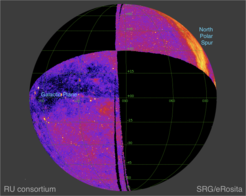SRG observatory completes X-ray map of half the sky
X-ray astronomers and astrophysicists in Russia and Germany working from their home offices with the Spectrum RG orbital observatory have reached an important milestone – the ART XC and eROSITA telescopes aboard Spectrum RG completed a map of half of the sky.

The total area of the celestial sphere is 41 253 square degrees. By the end of March, the SRG/eROSITA telescope has scanned an area covering more than 20 637 square degrees. In the quarter of the sky, for which the Russian consortium is responsible for processing and analysis, more than 125 000 X-ray sources have been detected. Among them are tens of thousands of AGN and quasars, which are powered by accretion of matter onto supermassive black holes, and more than а thousand clusters of galaxies filled mainly with mysterious dark matter. The vast majority of these objects are located at cosmological distances exceeding billions of light years.
The X-ray map also reveals many thousands of stars with active coronae that are much more luminous in X-rays than our Sun, as well as remnants of supernova explosions, pulsars, accreting white dwarfs and many other types of galactic X-ray sources. Many of these objects are observed for the first time. Their positions on the sky are measured with good accuracy, often better than 10 arcseconds, allowing astrophysicists to match them with objects known at optical and infrared wavelengths.
On the map, the North Polar Spur is evident, which is the brightest and largest region of our home galaxy in soft X-rays. The nature of this feature remains unclear, although several scenarios are being discussed. There is also an obvious dark stripe, extending along and slightly above the plane of the Milky Way, where the surface brightness of X-ray radiation is lower than in other parts of the map. This darker region appears because of absorption of soft x-rays by gas and dust in this part of the galaxy.
The SRG observatory scans the sky along a large circle of the celestial sphere with a rotating plane that approximately follows the motion of Earth around the Sun. All scans intersect at the ecliptic poles above the plane of the solar system, where the X-ray map thus attains its highest sensitivity. The density of objects detected by SRG/eROSITA in these zones reaches 350 sources per square degree.
The SRG sky survey continues. Every day, Roscosmos’ Lavochkin Association operates the satellite and monitors its health, two large antennae of the Russian deep space network (a 70-metre dish in Ussuriysk and 64-metre dish in Bear Lakes near Moscow) receive scientific data and send commands to the satellite and scientific instruments currently travelling at a distance of one and a half million kilometres from Earth (four times further than the Moon). Scientists of the two SRG/eROSITA consortia, led respectively by the Space Research Institute of the Russian Academy of Sciences (Moscow) and by the Max-Planck Institute for Extraterrestrial Physics (Garching near Munich), are processing and analyzing the scientific data.
It is expected that the first X-ray map of the full sky will be completed by Spectrum RG by the end of June this year.
